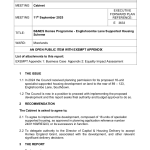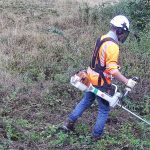The decision by BANES to suspend development of the Tufa Field has been widely welcomed. The new Council leader has started the process of looking again at the uses for the the area, against a backdrop of financial and political pressures.
There is no doubting now the presence of a climate emergency, though many have yet to grasp the scale and the impact on all our lives in the decades to come. There is also no doubting the woeful record on housebuilding of successive administrations since the Thatcher government stopped council housebuilding in the 1980’s.
If there is one outstanding Human Right above all others, it is the right to shelter. And in a civilised society, the right for that shelter to be affordable, sustainable and liveable. Homes not just houses.
But housing needs land, and green land needs to be at the forefront of our actions to mitigate climate change effect. So how do we square these two apparently contradictory requirements?
It should first be said that housebuilding, and house builders, is not an open business. The industry is dominated by a very few players, the top 4 accounting for 68% of house completions in 2019, from a paltry total of just 86,115 new houses built.
Yet at the same time, these house builders have up to 800,000 plots with planning permission that are not being developed.
The reasons for this are unclear, but there is certainly a thriving market in land-banking, with very little of the subsequent uplift in land values finding its way back into the public purse.
As Mark Twain said ” Buy land, they’re not making any more”.
There is also the question of construction practices. In the UK we are wedded to ‘traditional’ construction methods. These involve digging large holes and filling them in again, stacking stones and bricks on top of each other one by one and completing a series of fitting out processes which can only take place sequentially and usually in the worst of weather. . This makes house-building extraordinarily labour-intensive, expensive and slow. They are built using the least sustainable materials, often bad quality and never with the continued well-being of future occupants in mind.
Yet our factories for producing goods would never dream of doing anything so inefficient. So where are the mass-produced, factory-built, slot-together, cheap, high-quality homes we could have? Solving the housing crisis requires blowing apart the existing system and in this Local Authorities can play a part. While planning policy and building regulations are largely set at a national level, local authorities can set planning contexts, releasing land, brownfield or green, for closely regulated and controlled development, providing basic infrastructures for encouraging self-build and quick-build schemes over those controlled by the major house-builders.
What has this to do with the Tufa Field?
Maintaining the balance between green space provision and our need for high-quality affordable housing is a vital part of the job of the council and the Tufa Field is a prime example of a green urban space that must continue to exist for our own well-being as well as our duty to the world which we briefly inhabit. The current Local Plan partial update is a chance for everyone to make their views known, and insist on this balance.













 Total views : 99859
Total views : 99859

Leave a Reply